Northern NY Agricultural Development Program Small Grants Project Report 2007-2008
Extending the Season of Horticultural Production in Northern New York With High Tunnels
Project leaders:
- H. C. Wien, Professor, Department of Horticulture, Cornell University, hcw2@cornell.edu
- Amy Ivy, Executive Director, CCE Clinton County, adi2@cornell.edu
Collaborators:
- Anne Lenox Barlow, CCE Clinton County
- Mike Davis, E. V. Baker Research Farm, Essex County
- Emily Selleck, CCE, Essex County
- Richard Gast, CCE Franklin County
- Sue Gwise, CCE Jefferson County
- Joe Lawrence, CCE Lewis County
- Steve Vandermark CCE St. Lawrence County
Cooperating Farmers:
- Dan Kent, Heuvelton, St. Lawrence County
- Almeda Grandjean, Adams Center, Jefferson County
- Delores Desalvo, New Bremen, Lewis County
- Bruce Bonesteel, Malone, Franklin County
- Christine McCauliffe, Willsboro, Essex County
- Rob Hastings, Keene, Essex County
- Ken Campbell, Saranac, Clinton County
- Beth Spaugh, Peru, Clinton County
Background:
The short growing season in Northern New York makes production of high quality horticultural crops over a long marketing season a tremendous challenge. Methods of season extension have been listed as a major important research and extension need for Northern New York for 2008. The Adirondack Harvest project in eight Northern NY counties identified season extension as a high priority for direct market farmers, and the cooperating restaurants have specifically requested more fruits and vegetables from the region for their local meals.
In recent years, use of high tunnels (unheated greenhouse structures covered with a single layer of clear polyethylene plastic) has become popular as a season-extension technique in many parts of the world, but are so far little used in New York. Such a tunnel was erected at the Willsboro Farm in 2007 with financial support from Cornell’s Department of Horticulture. That project was established to demonstrate the utility of high tunnels to grow small fruits, vegetables and cut flowers in Northern New York and provide information for growers in the region.
Methods:
Testing automatic tunnel side openers: Ventilation is critical for high tunnel performance and it is mostly accomplished through roll-up sides. The long sides can provide much better ventilation as the air flows more uniformly across the crops than it would if only the ends were open. Opening and closing of the sides is so far a chore accomplished manually, requiring constant attention by the operator, because changes in sun exposure can quickly alter tunnel temperature. Automating the ventilation and controlling it by a thermostat is an innovation offered by a grower building and operating his own high tunnels, and we decided to test this mechanism on 4 high tunnels in three counties in NNY. Installation was carried out by each grower/cooperator under the guidance of Nelson Hoover, the son of the inventor, along with Judson Reid, CCE Yates Countyand Chris Wien. In August, this team consulted the growers to gather opinions on how well the side openers operated, and suggestions on design improvements.
New tunnel cover materials: Research at Penn State University and in Yates County has shown that conventional greenhouse plastic cover lets the heat escape from the tunnel at night. We tested a new cover material that reduces night-time heat loss on two growers’ high tunnels. Recording thermometers with two sensors were given to the growers to allow monitoring of air temperatures in the tunnel from late August on. The collaborating growers provided the daily maximum and minimum temperatures inside and outside the high tunnels on a weekly basis.
Test tender small fruit crops: Almeda Grandjean in Jefferson Cty. planted two varieties of fall-bearing raspberries in ground that was to be covered by a 20 x 96 ft. high tunnel in early summer 2008. A comparison of productivity, earliness and fruit quality of fall-bearing raspberries, blackberries and black raspberries was planted in the Willsboro high tunnel and in an adjacent field in 2006, and this trial was harvested for the first time in 2007 and continued in 2008.
Test varieties of cut flowers in high tunnels: Flower species that have been found to be attractive and valuable as cut flowers in Ithaca tests were tested in the high tunnel at the Willsboro Farm, and were slated to be tested in one grower’s tunnel in St. Lawrence Cty. At Willsboro, four varieties of cut flower sunflowers, and four varieties of lisianthus were transplanted into the high tunnel and outdoors, and their performances compared.
Results:
Automatic tunnel side openers: Installing the openers took a bit of creative mechanics and each of our cooperators came up with ways to customize the installation to suit their situation. Some of the modifications our growers suggested included:
- Anchoring the pole in the ground with a concrete footing or a crossbar welded to the base
- Enlarging the contact area for the switch sensor to strike
- Using a heavier duty switch sensor
- The vertical pole needs to be generously lubricated to allow smooth operation of the mechanism
- Allowing for swivel movement in the vertical pole to accommodate houses with slightly curved sides
- The cable to hold the weight of the motor was deemed unnecessary
- Consider how the baseboard lines up with the plastic; sometimes the roll of plastic gets hung up on the baseboard and the motor keeps running.
New tunnel cover materials: Growth in the high tunnels/greenhouses covered with the new IR-blocking polyethylene was good. In one case (Ken Campbell, Clinton Cty.), temperatures inside the house from mid-September to late October averaged 7 C higher during the day inside (23 C vs. 16 C outside), while night temperatures were 5 C higher inside (7 C inside vs. 2 C inside). More significantly, minimum temperatures outside dropped below freezing on 9 out of 31 nights, compared to none in the tunnel.
Berry and cut flower production: Production of strawberries, cane fruit and cut flowers was monitored at the Cornell Willsboro Research Farm in 2008. In general, strawberry earliness, yield and fruit quality was improved in the high tunnel compared to outside (Appendix Table 1). Raspberry performance showed similar trends. There were two harvest seasons, mid-summer and fall; these have been totaled in Table 2. Both sunflowers and lisianthus were taller and more productive in the tunnels compared to outside. In both locations, the plants could have used supports to prevent lodging. In general, for all the crops grown in the high tunnel at Willsboro, productivity was increased, and quality of the harvested products was improved.
Outreach:
2008 High Tunnel Conference: The latest information on high tunnel construction, production and marketing was shared in a 2-day conference at Saranac Lake (March 27-28), attended by 7 CCE staff (for training), 7 cooperating growers, 6 speakers and 44 in the audience. Attendees came from all NNY counties, the Capital District, Western NY and the province of Quebec. Lively discussions among participants maximized the sharing of information. A survey of participants indicated that 10 attendees have been producing crops in tunnels for at least a year, and 17 were in their first year of production, or seriously considering acquisition of a high tunnel.
Lewis County / Cooperator – Dolores DeSalvo: Having grown vegetables for years, Dolores planned to put up her first high tunnel this year but weather and other factors prevented her from doing this. She owns the tunnel and plans to erect it in April 2009.
Jefferson County / Cooperator – Almeda Grandjean: Almeda already has 2 50’ high tunnels in which she grows tomatoes, peppers, cucumbers and a variety of minor crops. For our project she planted fall-bearing raspberries and planned to erect a high tunnel over the planting in August/September. She planted 2 varieties, ‘Caroline’ and ‘Autumn Britten’ on June 6 and the next 2 months had near record levels of rainfall. The soil is well drained and the Autumn Britten thrived with the rain but Caroline barely grew and by the end of July most of those plants were dead. Once we were confident the soil was not infested with disease, Almeda erected the high tunnel structure over the planting area but did not cover it with plastic. She will plant the replacement plants in spring of 2009 and cover the tunnel in August for her first fall crop of berries. Almeda’s open house was August 20 with 26 people attending. Chris Wien and Judson Reid were the guest speakers.
St. Lawrence County / Cooperator – Dan Kent: We began this project with a different cooperator who withdrew from participation due to serious health issues. In late July we met Dan Kent and although it was too late to start a project we did consult with him on fertility issues with his tomatoes and he hosted a very well attended open house in September. Dan has a 200’ single bay Haygrove tunnel and wants to use organic methods. To reduce disease pressure he has been replacing the plastic every year. IPM Specialist, Betsy Lamb suggested he save money by using the plastic for a few years before changing. Dan’s open house was September 15 with 28 people attending. Betsy Lamb was the guest speaker, Amy Ivy facilitated.
Franklin County / Cooperator – Bruce Bonesteel: Bruce has had a garden center and retail produce stand for years and has recently become interested in growing some of his own produce. For this project he tried out the Hoover automatic tunnel opener on his 96’ tunnel. Bruce was extremely pleased once the system was fine tuned especially because of the freedom it gave him from having to check on the tunnel continually. “It took a fair bit of adjusting but once I got the bugs worked out of it, it opened and closed reliably, without issue,” Bruce said. Bruce’s open house was September 21 with 4 people attending. Chris Wien was the guest speaker, Amy Ivy facilitated.
Clinton County / Cooperators: Beth Spaugh and Ken Campbell: Beth Spaugh worked with the Hoover automatic tunnel opener on her 96’ Ledgewood high tunnel. She has been rolling up the sides by hand for the previous 2 growing seasons and greatly appreciated the freedom the automatic opener provided. It took some adjusting to set up and it still needed to be checked on daily but the thermostat control gave her freedom from constant checking. Beth’s open house was September 21 with 12 people attending. Chris Wien was the guest speaker, Amy Ivy facilitated.
Ken Campbell installed the IR-40 plastic on his hoop house on April 18. He started with bedding plants, followed by squash and beans in the ground until mid July. Then he built raised beds for lettuce, greens and green onions. The plastic was removed October 28. Ken’s open house was on September with 10 people attending. Chris Wien was the guest speaker, Amy Ivy facilitated. We also demonstrated the ag plastics baler using greenhouse plastic and black plastic mulch.
Essex County Cooperators: Christine McAuliffe and Rob Hastings: Christine McAuliffe worked with the Hoover automatic opener on her 96’ Ledgewood high tunnel. She also reported having to adjust the opener to work properly on her house but once installed it was a significant time saver. Her garden center is spread out with limited staff so the opener allowed the staff freedom to keep working, confident the opener would take care of temperature fluctuations during the day. Christine said the opener “caused less stress on our employees and most importantly on the plants. We also noticed that we were using less water when the auto-opener was working correctly.” Christine’s open house was August 27 with 9 people attending. Judson Reid, Nelson Hoover and Chris Wien were guest speakers, Amy Ivy facilitated.
Rob Hastings has 4 multi-bay Haygrove-type tunnels in which he grows tomatoes, cut flowers and fall raspberries. For our project he tried out the Luminance plastic from Haygrove on the raspberry tunnel and compared it with regular plastic over his other tunnels. He noticed a significant difference in the way light is diffused through the Luminance. Although the intensity was less, Rob feels his plants did better under it than under regular plastic. Rob’s open house was August 27 with 12 people attending. Judson Reid, Nelson Hoover and Chris Wien were guest speakers, Amy Ivy facilitated.
Conclusions/ Outcomes/Impacts:
Overall the growers liked the freedom the automatic openers gave them. But since some kinks were still being worked out the openers were not completely trouble free. The cold climate of NNY makes timely opening and closing a real benefit, especially in spring and fall the mornings start out cold. Growers rushing off to market benefit from knowing the tunnels will open at the optimum time for the crop instead of when the grower can finally get over to do it manually. If tunnels are left closed up on a chilly morning in May the temperatures can rise rapidly by late morning if the sun comes out. The automatic opener lets the grower work off-site. The suggestions made by growers who used the device will be incorporated into manufacture of an improved, more robust model that should again be tested in NNY.
Performance of the new high tunnel cover film on two growers’ tunnels proved satisfactory and substantiated that the covers improved tunnel growing conditions.
The comparisons of the product quality and yield of strawberries, raspberries and cut flowers in the Willsboro tunnels illustrated why interest is so high for high tunnels among growers. The results endorsed the gratifyingly high attendance at the high tunnel conference in Saranac Lake in March, and the keen interest in high tunnels at the open houses held on growers’ farms in the summer. Public support for locally produced foods can only augment this trend.
Appendix: Willsboro high tunnel yields:
Table 1. Strawberry yields inside and outside the high tunnel at the E V Baker Farm, Willsboro, NY in 2008.
|
Variety |
Inside tunnel |
Outdoors |
||
|
First harvest date |
Yield, lbs/100ft2 |
First harvest date |
Yield, lbs/100ft2 |
|
|
Earliglo |
6/10 |
63 |
6/14 |
46 |
|
Evangeline |
6/10 |
43 |
6/12 |
46 |
|
Jewel |
6/15 |
76 |
6/17 |
53 |
|
Everest |
6/10 |
29 |
6/15 |
23 |
Table 2. Yields of raspberry and blackberry inside and outside the high tunnel at Willsboro, totaled over the summer and fall harvest seasons in 2008.
|
Variety |
Yield, lbs/100ft2 |
|
|
Inside tunnel |
Outdoors |
|
|
Encore |
2.7 |
1.2 |
|
Jewel |
10.8 |
1.5 |
|
Kiwi Gold |
19.2 |
1.3 |
|
Heritage |
27.4 |
4.8 |
|
Prelude |
11.1 |
1.9 |
|
Prime Jean |
0.1 |
0 |
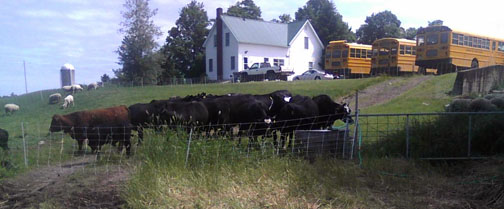
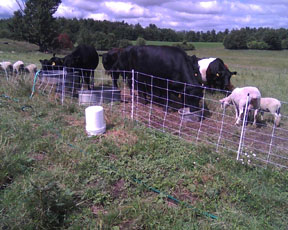
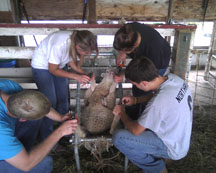
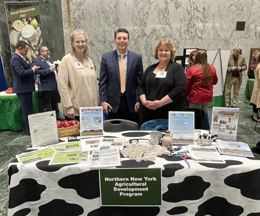
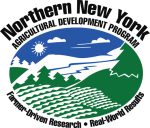

 Presentations at the NNYADP Research Update Meetings will share the latest data and information as one or both meetings as follows. At both meetings, Cornell University Nutrient Management Spear Program Director Quirine M. Ketterings, Ph.D. will present data from a suite of whole farm sustainability projects, including nutrient mass balance and greenhouse gas emissions footprinting; the value of manure, and the use of satellite imagery to determine crop yield stability zones.
Presentations at the NNYADP Research Update Meetings will share the latest data and information as one or both meetings as follows. At both meetings, Cornell University Nutrient Management Spear Program Director Quirine M. Ketterings, Ph.D. will present data from a suite of whole farm sustainability projects, including nutrient mass balance and greenhouse gas emissions footprinting; the value of manure, and the use of satellite imagery to determine crop yield stability zones. Also at both meetings, Uihlein Maple Research Forest Director Adam Wild will share information on how tapping into other-than-maple tree species for syrup production can increase maple producers and landowners’ economic potential, plus how a warming climate creates new challenges for sugarmakers.
Also at both meetings, Uihlein Maple Research Forest Director Adam Wild will share information on how tapping into other-than-maple tree species for syrup production can increase maple producers and landowners’ economic potential, plus how a warming climate creates new challenges for sugarmakers.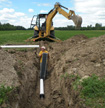 Miner Institute Research Scientist Laura Klaiber will share data from 10 years of edge-of-field drainage on the quality of surface runoff and tile drainage, the environmental and agronomic impacts of systematic tile drainage in corn and grass fields and when planting cover crops after corn harvest, and crucial insights into the water quality impacts of widely adopted farming practices.
Miner Institute Research Scientist Laura Klaiber will share data from 10 years of edge-of-field drainage on the quality of surface runoff and tile drainage, the environmental and agronomic impacts of systematic tile drainage in corn and grass fields and when planting cover crops after corn harvest, and crucial insights into the water quality impacts of widely adopted farming practices. Presenters at the March 20th NNYADP Research Update Meeting in Lowville will include Dr. Ketterings and Adam Wild as well as Cornell PRO-DAIRY Dairy Forage Systems Specialist Joe Lawrence discussing how producers can gain the most value from corn silage evaluation data from regional on-farm trials and how the evaluation process has change to determine the best fit for any single farm.
Presenters at the March 20th NNYADP Research Update Meeting in Lowville will include Dr. Ketterings and Adam Wild as well as Cornell PRO-DAIRY Dairy Forage Systems Specialist Joe Lawrence discussing how producers can gain the most value from corn silage evaluation data from regional on-farm trials and how the evaluation process has change to determine the best fit for any single farm.